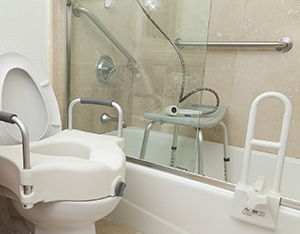Preventing Falls at Home
A person can fall for many reasons. Older adults may fall because reaction time slows as we age. Your muscles and joints may get stiff, weak, or less flexible because of illness, medicines, or a physical condition.
Other health problems that make falls more likely include:
-
Arthritis
-
Dizziness or lightheadedness when you stand up (orthostatic hypotension)
-
History of a stroke
-
Dizziness
-
Anemia
-
Certain medicines taken for mental illness or to control blood pressure.
-
Problems with balance or gait
-
Bladder or urinary problems
-
History of falling
-
Changes in vision (vision impairment)
-
Changes in thinking skills and memory (cognitive impairment)
-
Muscle weakness
-
Excessive alcohol use
Falls can cause serious injuries, such as head trauma, broken bones, dislocated joints, internal bleeding, and cuts. Injuries like these can limit your independence.
Prevention tips
To help prevent falls and fall-related injuries, follow the tips below.
Floors
To make floors safer:
-
Put nonskid pads under area rugs.
-
Remove small rugs.
-
Replace worn floor coverings.
-
Tack carpets firmly to each step on carpeted stairs. Put nonskid strips on the edges of uncarpeted stairs.
-
Keep floors and stairs free of clutter and cords.
-
Keep floors and stairs clear of animal and children's toys
-
Arrange furniture so there are clear pathways.
-
Clean up any spills right away. Don't walk on wet floors.
Bathrooms

To make bathrooms safer:
-
Install grab bars in the tub or shower.
-
Install a raised (elevated) toilet or toilet seat.
-
Apply nonskid strips or put a nonskid rubber mat in the tub or shower.
-
Sit on a bath chair to bathe.
-
Use bathmats with nonskid backing.
Lighting
To improve visibility in your home:
-
Keep a flashlight in each room. Or put a lamp next to the bed within easy reach.
-
Put nightlights in the bedrooms, hallways, kitchen, and bathrooms.
-
Make sure all stairways have good lighting. There should be a light switch at the bottom and the top of each stairway.
Other changes to make
-
Look around to find any safety hazards. Look closely at doorways, walkways, and the driveway. Remove or repair any safety problems that you find.
-
Wear shoes that fit well. Never go barefoot or wear socks or slippers with smooth soles.
-
See your eye care provider once a year if you wear glasses. This is to be sure the prescription is still right for you.
-
Take your time when going up and down stairs; always use handrails. Never carry items in both hands.
-
Wear an alert necklace or bracelet if you are already prone to falling.
-
Put handrails on both sides of stairs and in walkways for more support. To prevent injury to your wrist or arm, don’t use handrails to pull yourself up.
-
Use a "reach stick" to grab hard-to-reach items.
-
Install grab bars wherever needed to pull yourself up.
-
Arrange items that you use often. This will make them easier to find or reach.
-
Keep track of where your pets are so you don't trip over them when you are walking.
Online Medical Reviewer:
Marianne Fraser MSN RN
Online Medical Reviewer:
Robert Hurd MD
Online Medical Reviewer:
Tara Novick BSN MSN
Date Last Reviewed:
11/1/2022
© 2000-2024 The StayWell Company, LLC. All rights reserved. This information is not intended as a substitute for professional medical care. Always follow your healthcare professional's instructions.